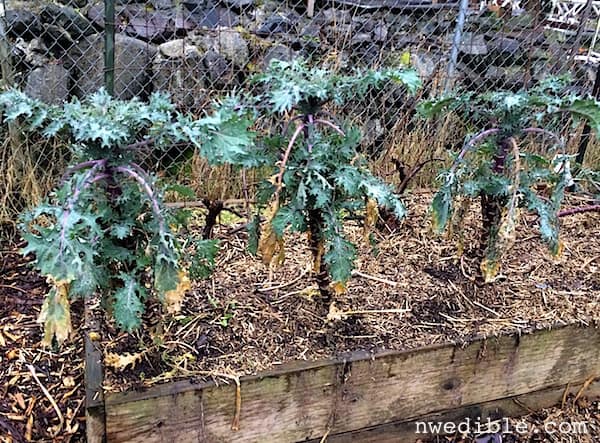January means one thing when you are a gardener: a mailbox stuffed to bursting with seed catalogs.
With a stack of seed catalogs and well-thumbed gardening books by our side, and ground that’s still too cold and wet to work, the name of the January game is planning and letting your imagination run wild.
I like the dirty action (heh!) of hands-on gardening as much as the next girl but this is the time to stare out the window at your garden with a mug of coffee. (Read why real gardeners should imagine their garden’s vistas from the window or try my technique of being a very lazy garden planner.)

Plan & Purchase
Enjoy seed catalogs, make huge fantasy seed lists, sketch out dream gardens, figure out where to put that next raised bed or pot. Take an inventory of your existing seeds, toss any that no longer germinate with verve or those varieties that you don’t actually enjoy.
Order the seeds you will want for this season. I like periodic sponsor of this blog, High Mowing Organic Seeds and recommend them without hesitation. Try a new variety or several but don’t go crazy just because everything in the catalog sounds good. None of us has unlimited space or time.
January and February are good months to place online orders for any bare-root fruit trees, bushes, canes or vines you might be adding to your garden this year. A good nursery will ship your plants to you at the right time to be planted in your area, before they begin breaking dormancy. I like Raintree Nursery for fruit and perennial edibles like that.
Onion starts and potato seed can also be pre-ordered from general seed houses and specialty growers for delivery based on your region. Even though you might not get these things delivered for a few months yet, the availability of favorite varieties is great now. If you wait, you might be out of luck.
Place Your Orders For:
- Spring & Summer Vegetable Seeds
- Bare Root Fruit and Nut Trees and Shrubs (pre-order)
- Bare Root Cane Fruit & Vines (pre-order)
- Onion Plants (pre-order)
- Potato Seed (pre-order)
Prepare and Prune
It’s not too early to start thinking about soil. If you live someplace where the ground isn’t frozen or waterlogged, you can amend your beds with lime, slow-release organic fertilizer, compost and whatnot in preparation for the spring planting. If you aren’t sure what your garden needs, get a soil test. And don’t go plopping anything fast acting like blood meal on your soil right now – you’ll just be wasting nitrogen (and money!).
By mid-month, spray peach trees that are prone to peach leaf curl with copper or lime sulfur. You’ll need to do three sprays total. (That’s kinda a lot of work – good reason to look at leaf-curl resistant varieties, if you ask me.)
Tackle dormant season pruning. Prune fruit trees for size, to remove crossing limbs, and to give the trees good air circulation and sun penetration.
Spray fruit trees with dormant oil to control mites, scale and overwintering buggies. You can use a specialty horticultural oil, or make your own.
Here’s my DIY Dormant Oil Spray Recipe:

Sow Indoors
Mid-January is about as early as even the most crazy gardeners get seeds going under light in the Northwest. That’s still plenty early for hardy vegetables and long-season crops and if you start too early you risk some types of crops bolting before they grow big enough to harvest.

Anytime from mid-month to the end of January, start these under lights if you want (but no pressure – we have lots of time still):
- Artichokes – My artichokes generally come through the winter, but when I need to replace them I sow seeds in 4″ pots mid-January.
- Onions and Summer Leeks – Use fresh seed, allium seed does not keep well.
- Salad Greens – From the end of January until mid-October, I’ll sow salad greens about every month or so. If you start lettuce under lights towards the end of January, you’ll be able to transplant out under a cloche at the beginning of March. If you didn’t get a bed prepared and cloched, keep those lettuces growing under lights and harvest them small right from the seed tray.
- Peas & Favas – most people sow peas and favas directly in the ground sometime between late February and April. If you want to get a jump on peas, you can start them indoors under lights as early as late January. Years I start peas early I sow them in a section of plastic gutter which works well.
Sow Outdoors
There’s no sensible reason to sow anything outdoors in January. But a gardener in January can become a decidedly un-sensible creature. So let’s just for a second assume that not being outside in the garden is simply killing you. Here’s what you do.
After you inventory your seeds for this year, collect up all the seed packets that aren’t making the cut because they are getting really old or aren’t your favorite varieties and make a “kitchen sink” seed blend to just play with. Mix in anything leafy – a random few sad old seeds of lettuce or spinach or beets or chard, plus arugula, kale, cabbage, cauliflower, radishes, etc. Now you have a guilt-free mesclun-style blend and if one of the varieties doesn’t germinate at all, who cares? Sow pretty thickly and if we get on of those freak February warm spells (hey, it could happen) you might be rewarded with an early crop of greens.
Harvest
I wish I had all these things in my garden. This winter I didn’t do any season extension and we got a decent cold snap, so pretty much it’s just a few sad kale plants and that gift that keeps on giving whether you want it to or not, Jerusalem Artichokes.

If you didn’t get Arctic blasted you might be enjoying any of the following:
- Beets
- Brussels Sprouts
- Overwintering Cabbage
- Carrots & Parsnips
- Kale & Collards
- Chard
- Leeks
- Turnips & Rutabagas
- Greenhouse Lettuce
- Jerusalem Artichokes
- Sprouting Broccoli
- Stored Potatoes
- Stored Winter Squash
How’s your garden planning going? Are you planning any changes or expansions this year?
0

This year we are converting to raised beds so I didn’t bother with a cover crop or any type of ground protection. Big mistake, the garden is one big mud hole right now. I just ordered a load of mulch to combat the mud. I’m dreading the hauling with this flabby, post-holiday binge body. Maybe it’ll get me in shape for the garden season?
My stack of seed catalogs are already dog eared with torn pages and I STILL can’t decide. I just need more space.
Our December was unusually mild, with a couple of loooong spates of above-freezing weather. We’re well into the -30 (Celcius) temperatures now, BUT until a week ago, my neighbour’s front-yard collards were still putting out growth. SLOW growth, but it was there. (The broccoli greens were long-gone, mind you).
We have a yard now(!!!) and I’m looking forward to growing as many tomatoes, cooking greens, snap/shelling beans, and winter squash as I can manage in whatever containers we can scrounge. (Our soil has some pretty significant lead poisoning, so containers are a requirement – we’re on the hunt for second hand horse troughs with this in mind). That said, just as you (I hope) are enjoying some stored winter squash, we’re enjoying the canning and freezing I did back in August-October. So far, so good. 🙂
I’m glad you’re back. I’ve missed your writing. 🙂
I love the idea of just mixing up stale seed and sowing it in winter just in case the weather cooperates. This would work even better by pre-germinating the seed indoors (just put a bunch of seed in a plastic bag with a wet paper towel). Scatter the sprouting seeds and cover with a bit of light soil and they ought to jump to life a lot faster than they would from dormancy in cold, wet soil.
Thank you so much for coming back! …and for posting these monthly posts on garden activities. In the past I’ve only grown a few zucchini and tomatoes along the fence. I’m hoping this year to expand significantly and maybe even test grow some fruit. I’ve got so much to learn and this blog is a great resource even if it’s not for my region. Thanks again!
I did the old seed mix a couple of years back. I had broccoli, cilantro, carrots, lettuce,spinach. It was like a treasure hunt.
Bought my seeds, planning the greenhouse project, got a work party lined up for late January. Life is good. Welcome back to the blog world, Erica.
My main problem is sunlight. I live in Northern California (where sunlight is usually plentiful), but I’ve got some tall trees around my yard. It’ s a blessing and a curse, as it helps keep the house a bit cooler on those triple digit summer days. Any tips for those of us that are sun-challenged?
Great idea with old seeds. Unfortunately I just (this morning) disguarded my old seeds in buried garbage. I will rethink this for next year. Seeds are almost ordered!
Catalogs are piling up. with a half-@ss reading method of check marks next to those seeds I am thinking of ordering. Question marks are for possible ones to consider. Re-readings garner second, third, or more check marks, obviously biased by the lovely garden porn photos of some of those choices. In a couple of weeks or so, I’ll cull the least-tagged or too-pricey catalogs. The multi-checked seeds get listed, and I cluster orders to fit within the shipping/handling charges, and I finally laboriously fill out the order pages, just to force one last reconsideration before writing checks and sending them on their way. Postage costs don’t really hurt, they just apply that final subliminal retarding effect, but I somehow always end up with lots of left-over seeds. They might linger in the file-folder storage box an additional year or two, but then they get tossed on weedy, marginal patches just to see if they can sprout. Most don’t, but they help to hold off erosion effects. Or so I rationalize.
I’m enjoying my escarole here in Oregon. I love escarole so much and can hardly be bothered with lettuce any more.
I was so jazzed to find all the new posts for January! I love your blog. Stop writing books.
No, I don’t really mean that. I think it’s awesome that you finished your book and I will buy it, because I’m sure it will be fantastic. And I’m glad you took the much-needed break. But please know that you were very much missed! Happy new year!
Welcome back! And congratulations on your book, woohoo!!
Because I was gone from home when the first arctic blast occurred (mid-November) and somebody (cough) left the hoop house open, I don’t even have hoop house overwintered veg to pick from, poor me! So I can’t wait for spring! In January I plant perennial flowers in flats and start my ginger. Have you ever grown your own ginger root? If you can grow artichokes (I think they are challenging to grow!) you can grow ginger! I love growing my own ginger root, but it really has to be started early. If you don’t mind my sharing my link, here’s how I do it:http://vomitingchicken.com/growing-ginger-easy-1-2-3-erm-4/
http://vomitingchicken.com/growing-ginger-easy-1-2-3-erm-4/
I’m a bit north of you 😉 and manage to garden all winter long. (It’s an obsession, I tells ya…an obsession…) Great article.
My growing conditions are similar to yours right? I live in NW Portland Oregon.